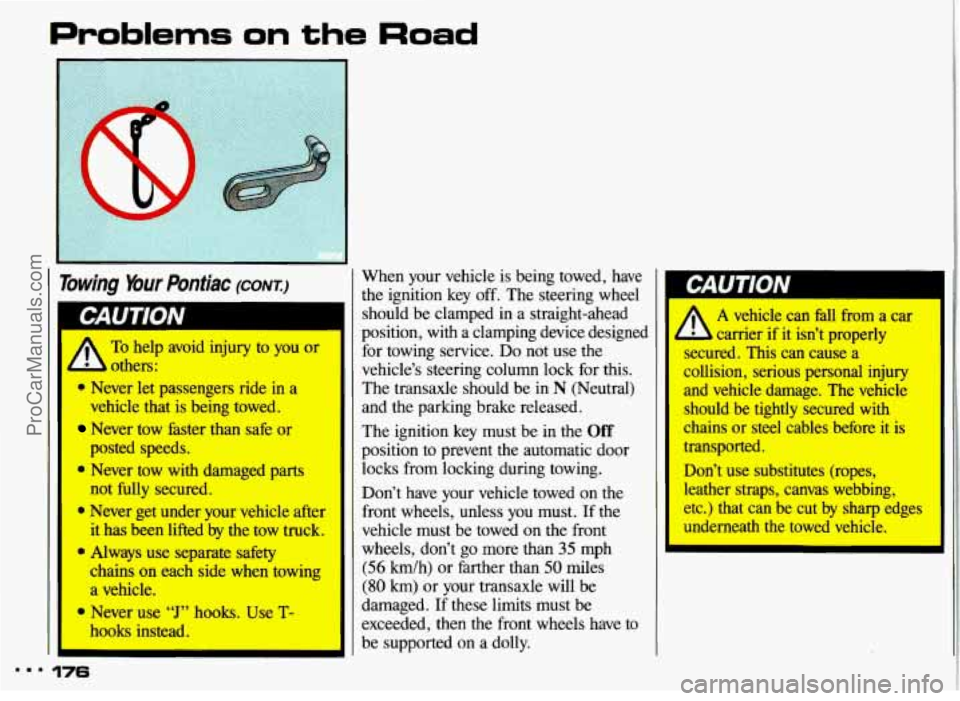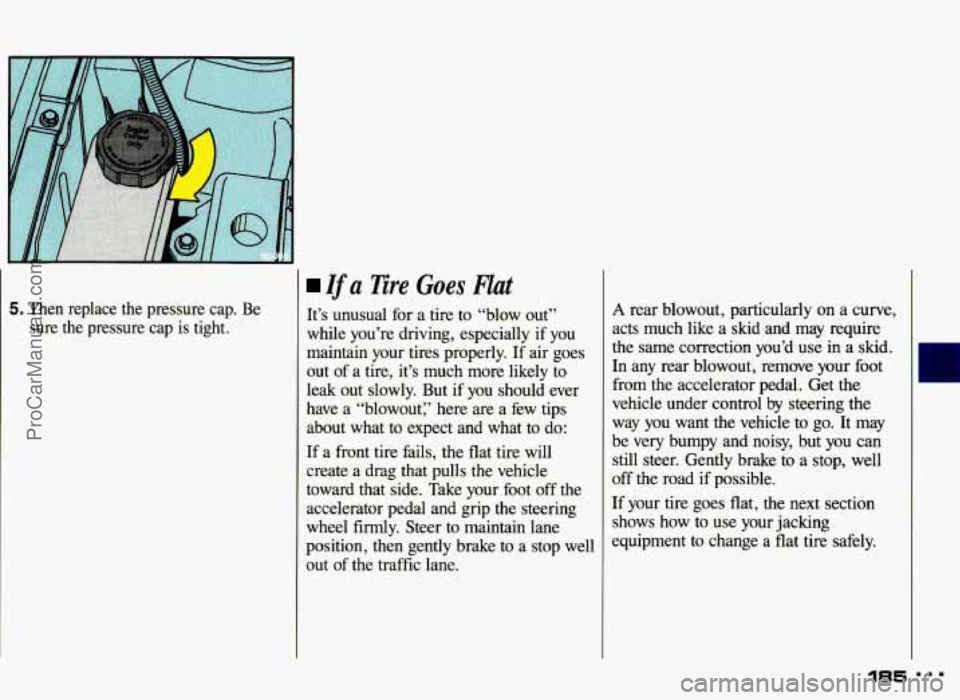Page 177 of 306

Problems on the Road
Towing Your Pontiac (CONT.:)
A others:
To help avoid injury to you or
0 Never let passengers ride in a
vehicle that is being towed.
Never tow faster than safe or
0 Never tow with damaged parts I
posted speeds.
0 Always use separate safety
chains on each side when towing
a vehicle.
hooks instead.
9 Never use “J” hooks. Use T-
... 176
When your vehicle is being towed, have
the ignition key off. The steering wheel
should be clamped
in a straight-ahead
position, with a clamping device designed for towing service.
Do not use the
vehicle’s steering column lock for this.
The transaxle should be
in N (Neutral)
and the parking brake released.
The ignition key must be in the
Off
position to prevent the automatic door
locks from locking during towing.
--
not fully secured. Don’t have your vehicle towed on the
Never get under your vehicle after front wheels, unless you must. If the
it has been lifted by the tow truck. vehicle must be towed on the front
wheels, don’t go more than
35 mph
(56 km/h) or farther than 50 miles
(80 km) or your transaxle will be
damaged. If these limits must be
exceeded, then the front wheels have to
be supported
on a dolly.
‘I
I‘
W
I A vehicle can fall from a car
b carrier if it isn’t properly
secured. This can cause a
collision, serious personal injury
I and vehicle damage. The vehicle
should be tightly secured with
chains or steel cables before it is
transported.
Don’t use substitutes (ropes, leather straps, canvas webbing,
etc.) that can be cut by sharp edges
underneath the towed vehicle.
ProCarManuals.com
Page 186 of 306

5. Then replace the pressure cap. Be sure the pressure cap is tight.
Ifa 3iii.e Goes Hat
It’s unusual for a tire to “blow out”
while you’re driving, especially
if you
maintain your tires properly.
If air goes
out of a tire, it’s much more likely to
leak out slowly. But if you should ever
have a “blowout:’ here are
a few tips
about what to expect and what
to do:
If a front tire fails, the flat tire will
create a drag that pulls the vehicle
toward that side. Take your foot
off the
accelerator pedal and grip
the steering
wheel
firmly. Steer to maintain lane
position, then gently brake to a stop well
out of the traffic lane.
A rear blowout, particularly on a curve,
acts much like a skid and may require
the same correction you’d use in a skid.
In any rear blowout, remove your foot
from the accelerator pedal. Get the
vehicle under control by steering the
way
you want the vehicle to go. It may
be very bumpy and noisy, but you can
still steer. Gently brake to a stop, well
off the road
if possible.
If your tire goes flat, the next section
shows how to use your jacking
equipment to change a flat tire safely.
185 I I..
ProCarManuals.com
Page 187 of 306
Problems on the Road
Changing a Flat lire
If a tire goes flat, avoid further tire and
wheel damage by driving slowly to a
level place. Turn
on your hazard
warning flashers.
186
IUII
Changing a tire can cause an injury. The vehicle can slip off the jack and
roll over you or other people. You and they could be badly injured. Find I
a level place to change your tire. To help prevent the vehicle from moving:
1. Set the parking brake firmly.
2. Put an automatic shift lever in P Wk). I
3. Shift a manual transaxle to 1 or R (Reverse).
4. Turn off the engine.
To be even more certain the vehicle won't move, you can put chocks at the
front and fear of the tire farthest away from the one being changed. That
would be the tire on the other side of the vehicle, at the opposite end.
ProCarManuals.com
Page 193 of 306

Changing a Flat Tire (corvr)
14. Store the flat tire in the compact
spare
tire compartment, and secure
with the
wing bolt and extension.
Store the jack and wheel wrench in
their compartment, also.
I A Storing a jack, a tire, or other
- equipment in the passenger
ompartment
of the vehicle could I
cause injury. In a sudden stop or
collision, loose equipment could strike someone. Store all these in
the proper place.
i
Compact Spare Tire
Although the compact spare was fully
inflated when your vehicle was new, it can lose air after a time. Check the
inflation pressure regularly. It should be
60 psi (420 Wa). The compact spare is
made to go up to
3,000 miles (5 O00 km),
so you can finish your trip and have
your full-size tire repaired or replaced
where you want.
Of course, it’s best to
replace your spare with a full-size tire as
soon
as you can. Your spare will last
longer and be in good shape
in case you
need it again.
Your anti-lock brake system warning
light may come on when you are driving
with a compact spare. See the
Idex
under Anti-Lock Brake System Warning
Light.
192
Don’t take your compact spare
through
an automatic vehicle wash I
with guide rails. The compact spare can get caught on the rails.
That can damage the tire and
wheel, and maybe other parts
of
your vehicle.
)on? use your compact spare on some
)ther vehicle.
ind don’t
mix your compact spare or
vheel with other wheels or tires. They
von’t
fit. Keep your spare and its wheel
ogether.
ProCarManuals.com
Page 198 of 306

Part 6
... N604
Here you will find information
about the care of your Pontiac
. This
part begins with service and fuel
information. and then it shows how
to check important fluid and
lubricant levels
. There is also
technical information about your
vehicle. and a section devoted to its
appearance care
.
Service & Appearance Care
Service ................ .................................. 198
Fuel
........................................................... 199
HoodRelease .................................................... 205
Engineoil
...................................................... 209
Aircleaner
...................................................... 214
Transaxle Fluid
.................................................. 216
Engine Coolant
.................................................. 221
Power Steering Fluid
.............................................. 224
Windshield Washer Fluid
........................................... 224
Brakes
......................................................... 225
Battery
......................................................... 227
BulbReplacement
................................................ 228
Windshield Wiper Blade Replacement
................................. 230
Loading Your Vehicle
............................................. 230
Tires
.......................................................... 232
Appearancecare
................................................. 239
Vehicle Identification Number (VIN)
................................. 247
Add-on Electrical Equipment
....................................... 248
Fuses
& Circuit Breakers ........................................... 248
Capacities
& Specifications ......................................... 251
Fluids
& Lubricants ............................................... 253
Replacement Bulbs
............................................... 254
Normal Maintenance Replacement
Parts ............................. 257
197
ProCarManuals.com
Page 207 of 306
Service & Appearance Care
Hood Release (CONT.)
~1 CAUTION
An electric fan under the hood 1
IhlUlll 0
A
Things that burn can get
hot engine parts and start a
can start up and injure you fire. These include liquids like
even when the engine is not gasoline, oil, coolant, brake fluid,
running. Keep hands, clothing and windshield washer and other
tools away from any underhood fluids, and plastic or rubber. You
or others could be burned. Be
careful not to drop or spill things
that will burn onto a Rot engine,
I’
Before closing the hood, be sure all the
filler caps are on properly. Then lift the
hood to relieve pressure on the hood
prop. Remove the hood prop from the slot in the hood and return the prop to
its retainer. Then just let the hood down
and close
it firmly.
... 206
ProCarManuals.com
Page 208 of 306
2.3L Quad OHC and Quad 4
Engines (CODES 3, D AND A)
When you open the hood, you'll see:
1 . Automatic Transaxle Dipstick
2. Brake Fluid Reservoir
3. Air Cleaner
4. Hydraulic Clutch Fluid Reservoir
5. Windshield Washer Fluid Reservoir
6. Battery
7. Power Steering Fluid Reservoir
8. Engine Oil Fill Cap, Engine Oil
9. Engine Coolant Surge Tank
(if equipped)
(if equipped)
Dipstick
ProCarManuals.com
Page 209 of 306
Service & Appearance Care
208
3300 V6 Engine (CODE N)
When you open your hood, you’ll see:
1. Power Steering Fluid Reservoir
2. Automatic Transaxle Fluid Dipstick
3. Brake Fluid Reservoir
4. Air Cleaner
5. Windshield Washer Fluid Reservoir
6. Battery
7. Engine Oil Fill Cap
8. Engine Oil Dipstick
9. Engine Coolant Surge Tank
(if equipped)
ProCarManuals.com